The Family Farm segment on 60 Minutes highlights a crisis unfolding far from metropolitan news desks but central to the nation’s economic and cultural identity. In Tennessee and Missouri, farmers who have spent generations cultivating soybeans now face financial strain triggered by China’s decision to halt purchases in response to the White House’s reciprocal tariffs strategy. The story presented a snapshot of hardship, but the wider picture reveals the fragility of the modern agricultural system and the pressures weighing on those who work the land.
For many of these families, farming is more than a livelihood. It is a heritage passed from parent to child, often with the hope that each generation will build upon the last. The sudden shock to the soybean market, followed by long stretches of uncertainty, has transformed that hope into a fear shared across rural America: the fear of being the generation that loses the farm.
- 60 Minutes Reports on “The Family Farm”, “Collateral Damage” & “The Indomitable Margaret Atwood” November 9 2025
- “Collateral Damage”: 60 Minutes Examines the High-Pressure Battle Inside University Labs
- The Indomitable Margaret Atwood: 60 Minutes Explores the Mind Behind a Cultural Icon
How the Trade Standoff Reshaped Rural Markets
The tariff dispute between the United States and China hit the soybean industry at a vulnerable moment. China had long been America’s largest soybean buyer, purchasing tens of millions of tons annually for animal feed and food production. When the country halted buying in retaliation to U.S. tariff measures, the market rapidly contracted. Prices fell, surplus stock piled up, and farmers across the Midwest and South were left unable to command rates that could cover their rising production costs.
Soybean farming operates on thin margins. Seed, fertilizer, fuel, machinery maintenance, and land loans leave little room for volatility. Even before the trade dispute, farm incomes had been declining for several years due to fluctuating global demand and unpredictable weather. The tariff fallout magnified those issues, creating a difficult environment where even large, well-managed operations struggled to stay afloat.
The Emotional Toll Behind the Numbers
Beyond financial calculations lies an emotional burden. The farmers interviewed in the segment spoke about long nights spent worrying over loan payments, the cost of next season’s seed, and the possibility of surrendering land their families have tended for decades. Many have delayed equipment upgrades, postponed retirement plans, or taken on second jobs just to maintain the farm’s viability.
The strain extends to families who often share in both the labor and the uncertainty. Spouses take on extra work, children step in during harvests, and entire households adjust to fluctuating income. The fear of closure is not just economic but deeply personal: losing the farm often means losing a family’s history and sense of identity.
The Bigger Picture: Rural America at a Crossroads
The challenges explored in the segment reflect larger shifts reshaping rural America. Consolidation has increased as large agribusinesses buy out smaller operations unable to weather financial downturns. Younger generations are increasingly reluctant to enter an industry marked by instability, leaving aging farmers without successors. Infrastructure—from grain elevators to transportation networks—depends on stable production and local investment, both of which falter when farms struggle.
At the same time, global pressures continue to shape domestic realities. Climate unpredictability affects yields. International competition pushes prices lower. Government policies fluctuate from administration to administration, making it difficult for farmers to plan long-term. The combination of these forces places rural communities in a precarious position where one bad season or one policy shift can have years-long consequences.
What Survival Looks Like Moving Forward
For many farmers featured in the 60 Minutes story, survival now depends on adaptability. Some diversify crops, others explore specialty markets, and many rely on government subsidies designed to offset trade losses. Still, these solutions offer only temporary relief. Long-term stability requires consistent global demand, supportive national policy, and financial structures that allow family farmers to compete with industrial operations.
There is still resilience in these communities. The segment captured a sense of determination rooted in decades of hard work and deep commitment to the land. Yet determination alone cannot overcome systemic pressures. The future of the family farm hinges on whether trade relationships stabilize, markets recover, and policymakers recognize the essential role these farms play in feeding the country—and in sustaining the cultural foundation of rural America.
A Defining Moment for American Agriculture
The Family Farm segment offers a window into a defining moment for American agriculture. It reveals the human experience behind trade disputes and economic shifts, grounding national policy in the lived reality of those most affected. As farmers in Tennessee, Missouri, and across the country confront an uncertain path ahead, the story serves as a reminder of the value of their work and the stakes of their struggle. The fight to save the family farm is more than a battle for economic survival—it is a fight to preserve a way of life.
More 60 Minutes November 9 2025
- 60 Minutes Reports on “The Family Farm”, “Collateral Damage” & “The Indomitable Margaret Atwood” November 9 2025
- “The Family Farm”: 60 Minutes Reveals the Hidden Cost of the Trade War on Farmers
- “Collateral Damage”: 60 Minutes Examines the High-Pressure Battle Inside University Labs
- The Indomitable Margaret Atwood: 60 Minutes Explores the Mind Behind a Cultural Icon
More Feature Articles
- “The Trouble in Bardstown”: Dateline Explores Crystal Rogers Case November 7 2025
- “You Took My Daughter”: 20/20 Reports on Holley Wimunc Homicide November 7 2025
- “The Han Family Murders”: 48 Hours Revisits a Chilling Triple Homicide November 8 2025
- “Christy Martin – The Fight of Her Life”: 48 Hours Reports November 8 2025
- 60 Minutes Reports on “The Family Farm”, “Collateral Damage” & “The Indomitable Margaret Atwood” November 9 2025

